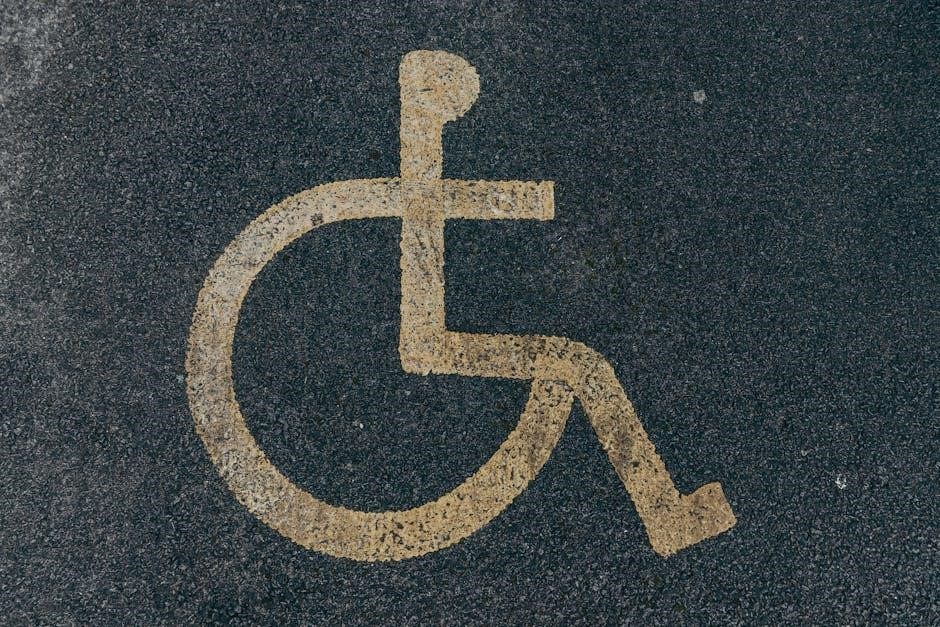wheelchair measurement guide
To determine the correct wheelchair size, consider the user’s needs and lifestyle, using a tape measure and healthcare professional for accurate measurements and guidance always available online resources.
Understanding the Importance of Proper Wheelchair Measurements
Proper wheelchair measurements are crucial for ensuring the user’s comfort, safety, and mobility. Incorrect measurements can lead to discomfort, poor posture, and even health complications. A well-fitting wheelchair can significantly improve the user’s quality of life, allowing them to participate in daily activities with ease and confidence. Measuring the user’s body and selecting the right wheelchair size can be a complex process, requiring careful consideration of various factors, including the user’s lifestyle, mobility needs, and personal preferences. By understanding the importance of proper wheelchair measurements, individuals can take the first step towards finding the perfect wheelchair, one that meets their unique needs and enhances their overall well-being, with the help of online resources and guidance from healthcare professionals, making the process easier and more accurate, every time, for everyone involved.

Assessing Mobility Needs and Lifestyle
Evaluate daily activities and environments to determine wheelchair requirements and usage patterns always considering user needs.
Determining the Purpose of the Wheelchair and Its Primary Use
To determine the purpose of the wheelchair, consider the user’s lifestyle and needs, including daily activities, work, and leisure time, and whether the wheelchair will be used for sports or recreational activities; The primary use of the wheelchair will help guide the selection process, ensuring the chosen wheelchair meets the user’s specific requirements. A healthcare professional can provide valuable guidance on determining the purpose and primary use of the wheelchair, taking into account the user’s mobility needs and lifestyle. By understanding the purpose and primary use, users can choose a wheelchair that is tailored to their needs, providing optimal comfort, support, and functionality. This information is crucial in selecting the right wheelchair, and users should consider their specific needs and requirements when making a decision. The wheelchair’s purpose and primary use will ultimately impact the user’s overall satisfaction and experience.

Measuring the Person for a Wheelchair
Accurate measurements require a tape measure and healthcare professional involvement always.
Using a Tape Measure and Involving a Healthcare Professional
To ensure accurate measurements, a tape measure is essential, and involving a healthcare professional, such as an occupational therapist, can provide valuable guidance and expertise in the measurement process, considering the user’s specific needs and requirements, and helping to determine the most suitable wheelchair size and type, while also taking into account any postural or mobility issues that may affect the user’s ability to use the wheelchair safely and comfortably, and providing recommendations for any necessary adjustments or customizations to the wheelchair to ensure a proper fit and optimal use, and ultimately, to improve the user’s overall mobility and quality of life, with the help of a healthcare professional and a tape measure, the measurement process can be completed efficiently and effectively.
Seat Size and Depth Considerations
Seat width and depth are crucial for comfort and usage, typically ranging from 16 to 20 inches, with depth measured from back to front edge always.
Understanding the Impact of Seat Width and Depth on Comfort and Usage
The seat width and depth of a wheelchair have a significant impact on the user’s comfort and usage. A seat that is too narrow or too wide can cause discomfort and affect the user’s ability to propel the wheelchair. The depth of the seat is also crucial, as it needs to provide adequate support for the user’s thighs. A seat that is too shallow can cause the user to slide forward, while a seat that is too deep can cause pressure on the back of the legs. The ideal seat width and depth will vary depending on the individual user’s needs and preferences. By considering these factors, users can find a wheelchair that provides optimal comfort and support, allowing them to use it with ease and confidence. This is essential for daily use and overall satisfaction.

Body Measurements for Wheelchair Fitting
Accurate body measurements are essential for proper wheelchair fitting and optimal support always using a tape measure correctly every time.
Relating Body Measurements to Postural Support and Wheelchair Specifications
Relating body measurements to postural support and wheelchair specifications is crucial for optimal wheelchair fitting and user comfort. The measurements are used to determine the correct seat width, depth, and height, as well as the type of postural support required. This information is then used to select the most suitable wheelchair model and configure it to meet the user’s specific needs. The goal is to provide adequate support and stability, while also allowing for comfortable movement and mobility. By considering the user’s body measurements and postural support requirements, healthcare professionals can recommend the most appropriate wheelchair specifications, ensuring a proper fit and optimal user experience. This process involves careful consideration of various factors, including the user’s lifestyle, mobility needs, and personal preferences, to ensure the selected wheelchair meets their unique requirements and provides long-term comfort and support.

Electric Wheelchair Specifications and Measurements
Electric wheelchairs have specific measurements, typically 30 to 34 inches wide and 40 to 50 inches long, varying by model and manufacturer always considering user needs.
Considering Motorized Wheelchair Width and Length for Optimal Use
When selecting a motorized wheelchair, it is essential to consider the width and length to ensure optimal use. The width of the wheelchair will impact its ability to navigate through doorways and tight spaces. A narrower wheelchair will be more suitable for indoor use, while a wider wheelchair may be more suitable for outdoor use. The length of the wheelchair will also impact its stability and maneuverability. A longer wheelchair will provide more stability, but may be more difficult to maneuver in tight spaces. It is crucial to consider the user’s specific needs and environment when selecting a motorized wheelchair. By doing so, the user can ensure that their wheelchair is tailored to their individual requirements, providing them with the greatest level of independence and mobility. This consideration is vital for optimal use and user satisfaction.
